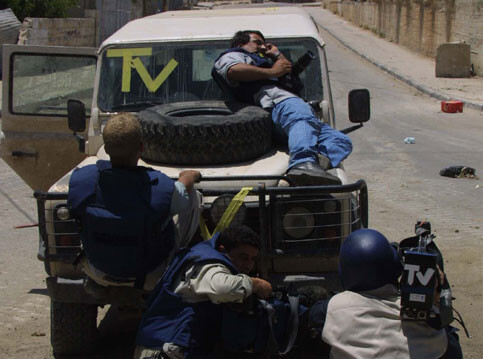Reporters Without Borders 21 June 2004

The press operating in the occupied Palestinian territories under difficult circumstances (Jafar Ishtayeh)
In a 21 June 2004 letter to Israeli Defence Minister Shaul Mofaz, RSF protested a string of violent attacks by the Israeli Army against Palestinian journalists in the Nablus region of the West Bank between 10 and 15 June.
“The methods the Israeli Army uses to hamper the international media from covering its clashes with Palestinians over the construction of its security fence are unacceptable,” RSF said. “Last week, the army resorted to intimidation and threats and fired tear gas canisters directly at journalists, injuring two of them. It is evident that during its operations, the Israeli Army systematically obstructs the work of Palestinian journalists. The army also shows little concern for their safety, taking insufficient precautions to avoid injuring these civilians, who have to be there in order to report on the situation.”
On 10 June, Palestinian photographer Alaa Badarneh, of the European Press Agency (EPA), went to al-Zawiyeh, a village located about 30 km south of Nablus, to cover protests by Palestinian residents against the building of the security fence. He described how soldiers broke up the demonstration with tear gas. One soldier who was about 40 metres away targeted him, firing a tear gas canister directly at his legs. Badarneh was picked up at the scene in a private car and, after going through several Israeli roadblocks, reached a Nablus hospital, where he was kept under observation for the day. He had been clearly identifiable as a journalist, wearing a fluorescent jacket marked “PRESS”.
On 13 June, Jaafar Ishtayeh, a Palestinian photographer with Agence France-Presse (AFP), was slightly injured in the back by a tear gas canister in al-Zawiyeh. He was taken to hospital and discharged after treatment, but was unable to resume work for several days.
On 14 June, Associated Press (AP) photographer Nasser Ishtayeh also went to al-Zawiyeh, where demonstrations were continuing. He arrived in the village after waiting for more than one hour at a military checkpoint and was threatened by soldiers. He reported that one of them told him, “Watch out, we have already injured two of your friends. You better take care if you don’t want to be the third.”
Photographer Abed Qusini of the British news agency Reuters narrowly avoided arrest in al-Zawiyeh on the same day. Qusini said he was with a group of Palestinian journalists taking photographs, when a soldier ordered him to stop on the grounds that the area had been declared a “closed military zone”. Qusini, who reads Hebrew, asked to see the written order and to photograph it to show Reuters that all journalists were banned from the area. One soldier and then a second grabbed his wrists and tried to seize his equipment. The journalist struggled and tried to use his mobile phone to call for help. An officer then ordered his arrest and soldiers attached his hand to their vehicle with plastic handcuffs. Fifteen minutes later, he was released, but threatened with further arrest unless he immediately left the scene.
The following day, 15 June, Qusini was working in Nablus, covering an Israeli Army incursion into the town. He was among a group of about a dozen journalists who were covering a military operation around a building. The soldiers used loudspeakers to insult them and threatened to destroy their equipment unless they left the area. Qusini protested and asked to see the order that it was a “closed military zone”. An officer became angry and called for his arrest. He was forced into an Israeli jeep and his jacket was ripped off and used to blindfold him. His colleagues only secured his release on the condition that they all immediately leave the area.
In a previous letter to the Israeli defence minister, RSF called for an “impartial, swift and rigorous” investigation into the shooting of 25 year-old AFP photographer Mahmoud Hams, who was wounded on 5 May in the Gaza Strip. The organisation has not yet received a response.
More Information